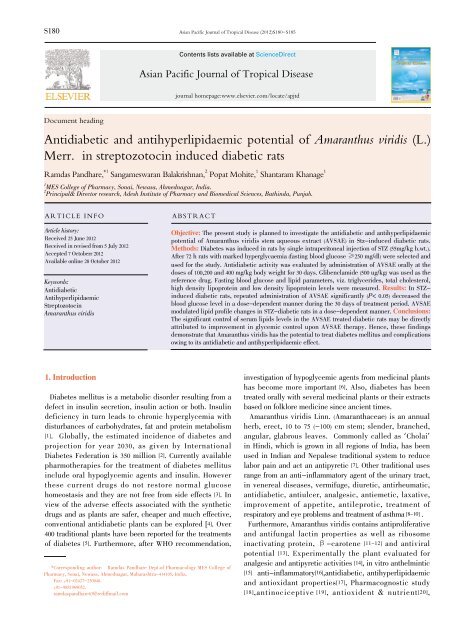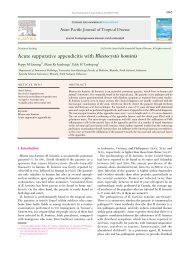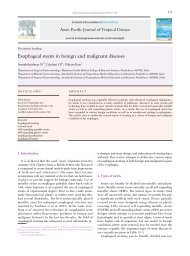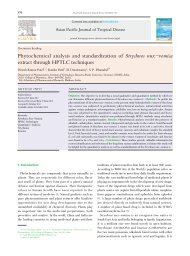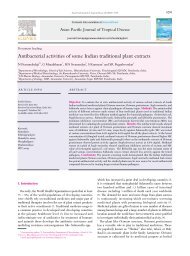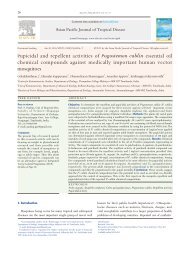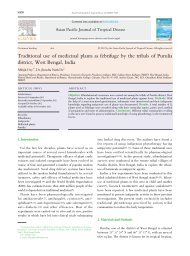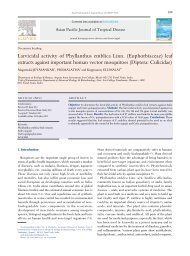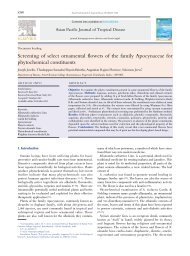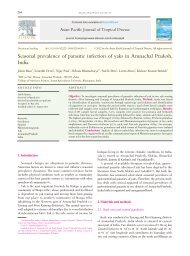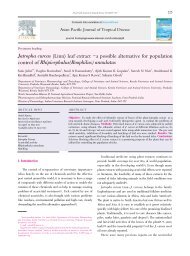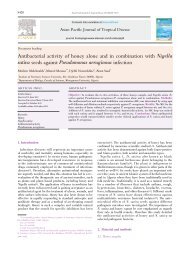Antidiabetic and antihyperlipidaemic potential of Amaranthus viridis ...
Antidiabetic and antihyperlipidaemic potential of Amaranthus viridis ...
Antidiabetic and antihyperlipidaemic potential of Amaranthus viridis ...
You also want an ePaper? Increase the reach of your titles
YUMPU automatically turns print PDFs into web optimized ePapers that Google loves.
S180<br />
Document heading<br />
Asian Pacific Journal <strong>of</strong> Tropical Disease (2012)S180-S185<br />
Asian Pacific Journal <strong>of</strong> Tropical Disease<br />
journal homepage:www.elsevier.com/locate/apjtd<br />
<strong>Antidiabetic</strong> <strong>and</strong> <strong>antihyperlipidaemic</strong> <strong>potential</strong> <strong>of</strong> <strong>Amaranthus</strong> <strong>viridis</strong> (L.)<br />
Merr. in streptozotocin induced diabetic rats<br />
Ramdas P<strong>and</strong>hare, *1 Sangameswaran Balakrishnan, 2 Popat Mohite, 1 Shantaram Khanage 1<br />
1 MES College <strong>of</strong> Pharmacy, Sonai, Newasa, Ahmednagar, India.<br />
2 Principal& Director research, Adesh Institute <strong>of</strong> Pharmacy <strong>and</strong> Biomedical Sciences, Bathinda, Punjab.<br />
ARTICLE INFO ABSTRACT<br />
Article history:<br />
Received 25 June 2012<br />
Received in revised from 5 July 2012<br />
Accepted 7 Octoberr 2012<br />
Available online 28 October 2012<br />
Keywords:<br />
<strong>Antidiabetic</strong><br />
Antihyperlipidaemic<br />
Streptozotocin<br />
<strong>Amaranthus</strong> <strong>viridis</strong><br />
1. Introduction<br />
Diabetes mellitus is a metabolic disorder resulting from a<br />
defect in insulin secretion, insulin action or both. Insulin<br />
deficiency in turn leads to chronic hyperglycemia with<br />
disturbances <strong>of</strong> carbohydrates, fat <strong>and</strong> protein metabolism<br />
[1]. Globally, the estimated incidence <strong>of</strong> diabetes <strong>and</strong><br />
projection for year 2030, as given by International<br />
Diabetes Federation is 350 million [2]. Currently available<br />
pharmotherapies for the treatment <strong>of</strong> diabetes mellitus<br />
include oral hypoglycemic agents <strong>and</strong> insulin. However<br />
these current drugs do not restore normal glucose<br />
homeostasis <strong>and</strong> they are not free from side effects [3]. In<br />
view <strong>of</strong> the adverse effects associated with the synthetic<br />
drugs <strong>and</strong> as plants are safer, cheaper <strong>and</strong> much effective,<br />
conventional antidiabetic plants can be explored [4]. Over<br />
400 traditional plants have been reported for the treatments<br />
<strong>of</strong> diabetes [5]. Furthermore, after WHO recommendation,<br />
*Corresponding author: Ramdas P<strong>and</strong>hare Dept.<strong>of</strong> Pharmacology MES College <strong>of</strong><br />
Pharmacy, Sonai, Newasa, Ahmednagar, Maharashtra-414105, India.<br />
Fax: +91-02427-230948.<br />
+91-9881969052.<br />
ramdasp<strong>and</strong>hare83@rediffmail.com<br />
Contents lists available at ScienceDirect<br />
Objective: The present study is planned to investigate the antidiabetic <strong>and</strong> <strong>antihyperlipidaemic</strong><br />
<strong>potential</strong> <strong>of</strong> <strong>Amaranthus</strong> <strong>viridis</strong> stem aqueous extract (AVSAE) in Stz-induced diabetic rats.<br />
Methods: Diabetes was induced in rats by single intraperitoneal injection <strong>of</strong> STZ (55mg/kg b.wt.).<br />
After 72 h rats with marked hyperglycaemia (fasting blood glucose ≥250 mg/dl) were selected <strong>and</strong><br />
used for the study. <strong>Antidiabetic</strong> activity was evaluated by administration <strong>of</strong> AVSAE orally at the<br />
doses <strong>of</strong> 100,200 <strong>and</strong> 400 mg/kg body weight for 30 days. Glibenclamide (500 ug/kg) was used as the<br />
reference drug. Fasting blood glucose <strong>and</strong> lipid parameters, viz. triglycerides, total cholesterol,<br />
high density lipoprotein <strong>and</strong> low density lipoprotein levels were measured. Results: In STZinduced<br />
diabetic rats, repeated administration <strong>of</strong> AVSAE significantly (P< 0.05) decreased the<br />
blood glucose level in a dose-dependent manner during the 30 days <strong>of</strong> treatment period. AVSAE<br />
modulated lipid pr<strong>of</strong>ile changes in STZ-diabetic rats in a dose-dependent manner. Conclusions:<br />
The significant control <strong>of</strong> serum lipids levels in the AVSAE treated diabetic rats may be directly<br />
attributed to improvement in glycemic control upon AVSAE therapy. Hence, these findings<br />
demonstrate that <strong>Amaranthus</strong> <strong>viridis</strong> has the <strong>potential</strong> to treat diabetes mellitus <strong>and</strong> complications<br />
owing to its antidiabetic <strong>and</strong> <strong>antihyperlipidaemic</strong> effect.<br />
investigation <strong>of</strong> hypoglycemic agents from medicinal plants<br />
has become more important [6]. Also, diabetes has been<br />
treated orally with several medicinal plants or their extracts<br />
based on folklore medicine since ancient times.<br />
<strong>Amaranthus</strong> <strong>viridis</strong> Linn. (Amaranthaceae) is an annual<br />
herb, erect, 10 to 75 (-100) cm stem; slender, branched,<br />
angular, glabrous leaves. Commonly called as ‘Cholai’<br />
in Hindi, which is grown in all regions <strong>of</strong> India, has been<br />
used in Indian <strong>and</strong> Nepalese traditional system to reduce<br />
labor pain <strong>and</strong> act an antipyretic [7]. Other traditional uses<br />
range from an anti-inflammatory agent <strong>of</strong> the urinary tract,<br />
in venereal diseases, vermifuge, diuretic, antirheumatic,<br />
antidiabetic, antiulcer, analgesic, antiemetic, laxative,<br />
improvement <strong>of</strong> appetite, antileprotic, treatment <strong>of</strong><br />
respiratory <strong>and</strong> eye problems <strong>and</strong> treatment <strong>of</strong> asthma [8-10] .<br />
Furthermore, <strong>Amaranthus</strong> <strong>viridis</strong> contains antiproliferative<br />
<strong>and</strong> antifungal lactin properties as well as ribosome<br />
inactivating protein, β-carotene [11-12] <strong>and</strong> antiviral<br />
<strong>potential</strong> [13]. Experimentally the plant evaluated for<br />
analgesic <strong>and</strong> antipyretic activities [14], in vitro anthelmintic<br />
[15] anti-inflammatory[16],antidiabetic, <strong>antihyperlipidaemic</strong><br />
<strong>and</strong> antioxidant properties[17], Pharmacognostic study<br />
[18],antinociceptive [19], antioxident & nutrient[20],
hepatoprotective activity [21].<br />
However, the literature survey revealed that there is no<br />
experimental evidence <strong>of</strong> antidiabetic effect <strong>of</strong> the stem part<br />
<strong>of</strong> the plant. Therefore, the present work was undertaken to<br />
explore the antidiabetic <strong>and</strong> <strong>antihyperlipidaemic</strong> <strong>potential</strong>s<br />
<strong>of</strong> <strong>Amaranthus</strong> <strong>viridis</strong> stem aqueous extract (AVSAE) in<br />
streptozotocin (STZ) induced diabetic rats.<br />
2. Materials <strong>and</strong> methods<br />
2.1. Plant material<br />
Plant specimen <strong>of</strong> <strong>Amaranthus</strong> <strong>viridis</strong> were collected<br />
during July 2010 from the Mahatma Phule Krishi Vidyapeeth,<br />
Rahuri, Maharashtra, India. The plant was authenticated<br />
by Dr. P.G. Diwakar, Joint Director, Botanical Survey <strong>of</strong><br />
India, Pune as <strong>Amaranthus</strong> <strong>viridis</strong> Linn. (Amaranthaceae)<br />
with a voucher specimen (BSI/WRC/Tech/2010/462) kept in<br />
herbarium, BSI, Pune.<br />
2.2. Chemicals<br />
Streptozotocin was purchased from Sigma Chemical<br />
Company, Bangalore. All other chemicals used in the<br />
experiments were purchased locally (Merck <strong>and</strong> S D fine<br />
Chemicals) <strong>and</strong> were <strong>of</strong> analytical grade. St<strong>and</strong>ard kits<br />
obtained from Span Diagnostics, India.<br />
2.3. Preparation <strong>of</strong> extract<br />
The stems <strong>of</strong> plant were washed with distilled water, shed<br />
dried <strong>and</strong> latter powdered. This powder was then defatted<br />
with petroleum ether which was further macerated with<br />
distilled water for 72 h with occasional shaking. It was then<br />
filtered <strong>and</strong> evaporated. The yield <strong>of</strong> AVSAE was 2.2% w/w.<br />
2.4. Preliminary phytochemical Screening<br />
The preliminary phytochemical screening <strong>of</strong> AVSAE<br />
was carried out for qualitative identification <strong>of</strong> type <strong>of</strong><br />
phytoconstituents present [22].<br />
2.5. Animals<br />
Healthy adult male wistar rats weighing 150-200g<br />
were obtained from in house breed at the animal house<br />
<strong>of</strong> M.E.S. College <strong>of</strong> Pharmacy, Sonai <strong>and</strong> were housed<br />
in polypropylene cages lined with husk in st<strong>and</strong>ard<br />
environmental conditions (Temperature 25依2 曟; relative<br />
humidity 55依10%; <strong>and</strong> 12:12 light: dark cycle,). The animals<br />
were fed on a st<strong>and</strong>ard pellet diet (Amrut rat <strong>and</strong> mice feed,<br />
Sangli, India) <strong>and</strong> water ad libitum.<br />
Animals were acclimatized to the laboratory condition for<br />
at least 8 days prior to the experiment <strong>and</strong> were maintained<br />
in a well ventilated animal house. The experimental protocol<br />
was approved by the Institutional animal Ethical Committee<br />
Ramdas P<strong>and</strong>hare et al./Asian Pacific Journal <strong>of</strong> Tropical Disease (2012)S180-S185 S181<br />
(MES/COP/IAEC/2010-11/03) <strong>and</strong> the care <strong>of</strong> the laboratory<br />
animals was taken as per the current CPCSEA regulations.<br />
2.6. Experimental design<br />
2.6.1. Acute toxicity study (OECD 420, 2001)<br />
The present study was conducted according to the<br />
organization for economic cooperation <strong>and</strong> development<br />
(OECD) revised fixed dose procedure for acute toxicity<br />
testing (OECD guideline 420, 2001). Two groups <strong>of</strong> five<br />
healthy albino wistar rats <strong>of</strong> either sex (3-month old, 150-200<br />
g b.wt.) were administered a limit dose <strong>of</strong> 2000 <strong>and</strong> 5000 mg/<br />
kg <strong>of</strong> the AVSAE <strong>and</strong> animals were observed for mortality<br />
<strong>and</strong> clinical signs for the first hour, then hourly for 3 h<br />
<strong>and</strong> finally periodically until 48 h. All <strong>of</strong> the experimental<br />
animals were maintained under close observation for 14<br />
days, <strong>and</strong> the number <strong>of</strong> rats that died within the study<br />
period was noted. The LD50 was predicted to be above 2000<br />
or 5000 mg/kg if three or more rats survived [23].<br />
2.6.2. Effect <strong>of</strong> AVSAE on normoglycaemic rats<br />
The rats were divided into four groups <strong>of</strong> 6 animals (n=6)<br />
each. Group I served as control <strong>and</strong> received vehicle. Group<br />
II, III <strong>and</strong> IV received AVSAE orally at doses 100,200 <strong>and</strong> 400<br />
mg/kg/day b.wt. Blood glucose levels were determined at<br />
0,1,2,3 <strong>and</strong> 4 h following treatment by retro-orbital plexus <strong>of</strong><br />
the eye under mild ether anaesthesia.<br />
2.6.4. Induction <strong>of</strong> diabetes<br />
Diabetes was induced in rats by single intraperitoneal<br />
injection <strong>of</strong> STZ (55mg/kg b.wt.) dissolved in freshly prepared<br />
0.01M citrate buffer, pH 4.5 [24] after 72 h rats with marked<br />
hyperglycemia (fasting blood glucose ≥250 mg/dl) were<br />
selected <strong>and</strong> used for the study.<br />
2.7. <strong>Antidiabetic</strong> <strong>and</strong> <strong>antihyperlipidaemic</strong> effect<br />
30 wistar rats <strong>of</strong> either sex (25 diabetic surviving <strong>and</strong> 05<br />
nondiabetic) were divided into six groups <strong>of</strong> 6 animals (n=6)<br />
each. The solution <strong>of</strong> AVSAE was prepared with 1% gum<br />
acacia, an emulsifying agent. Glibenclamide was served as<br />
a reference st<strong>and</strong>ard. Group-I (nondiabetic control) animals<br />
were received only 1% gum acacia (1ml/kg/day, p.o.), Group-<br />
II (diabetic control) animals were diabetic <strong>and</strong> received<br />
1% gum acacia (1ml/ kg/day, p.o.), Group-III (diabetic+<br />
glibenclamide) animals were diabetic <strong>and</strong> received<br />
glibenclamide (0.25 mg/kg/day, p.o.) <strong>and</strong> Groups IV, V, VI<br />
animals were diabetic <strong>and</strong> received graded doses <strong>of</strong> AVSAE<br />
100,200 <strong>and</strong> 400mg/kg, p.o. respectively. All the animals<br />
received above treatment daily up to 30 days.<br />
2.7.1. Evaluation <strong>of</strong> antidiabetic activity<br />
<strong>Antidiabetic</strong> activity <strong>of</strong> AVSAE was evaluated by estimation<br />
<strong>of</strong> blood glucose levels <strong>and</strong> body weight measurement on<br />
1st, 10th, 20th <strong>and</strong> 30th day <strong>of</strong> the study by using Glucometer<br />
(Optium omega, Abbott Diabetes Care Ltd).
S182<br />
2.7.2. Evaluation <strong>of</strong> Antihyperlipidaemic activity<br />
At the end <strong>of</strong> the experiment, the animals from each group<br />
were sacrificed by cervical dislocation <strong>and</strong> blood samples<br />
were collected to estimate various biochemical parameters<br />
[34]. Blood was collected from the heart <strong>and</strong> allowed to clot<br />
<strong>and</strong> the serum was separated by centrifugation at 3500 rpm<br />
for 10 minutes. Serum was assayed either immediately or<br />
stored at -200 C. The tissue like pancreas was collected <strong>and</strong><br />
used for histological studies. Serum samples were analyzed<br />
spectrophotometrically for triglycerides, total cholesterol,<br />
high density lipoprotein (HDL-C), using their respective kits<br />
using UV- visible spectrophotometer (Jasco V-630, Japan),<br />
VLDL-C <strong>and</strong> LDL-C were calculated as per Friedwald’s<br />
equation [25].<br />
VLDL = TG/5<br />
LDL = TC - (HDL + VLDL) [26-28].<br />
2.7.3. Oral glucose tolerance test OGTT)<br />
All the animals were given glucose (2 g/kg) 30 min after<br />
daily dosing. Blood samples were collected from the retroorbital<br />
plexus <strong>of</strong> the eye just prior (0 h) <strong>and</strong> 1, 2, 3 <strong>and</strong> 4 hr.<br />
after the glucose loading <strong>and</strong> blood glucose levels were<br />
estimated.<br />
2.7.4. Estimation <strong>of</strong> glycated hemoglobin<br />
After 30 days <strong>of</strong> treatment, the 12hr fasted rats were<br />
sacrificed by cervical decapitation, blood was withdrawn by<br />
retro orbital puncture under light ether anesthesia <strong>and</strong> the<br />
glycated hemoglobin was estimated [29].<br />
2.7.5. Statistical analysis<br />
The results were expressed as mean依S.E.M., statistical<br />
difference was done by using one-way analysis <strong>of</strong> varience<br />
(ANOVA) followed by Dunnette’s multiple comparison test.<br />
A difference in the mean P value
diabetic control groups (Table 5).<br />
4. Discussion<br />
Diabetes mellitus is probably the fastest growing metabolic<br />
disease in the world <strong>and</strong> as knowledge <strong>of</strong> the heterogeneous<br />
nature <strong>of</strong> the disease increases so does the need for more<br />
challenging <strong>and</strong> appropriate therapies. Traditional plant<br />
remedies have been used for centuries in the treatment<br />
<strong>of</strong> diabetes [30-32], but only a few have been scientifically<br />
evaluated. Therefore, we have investigated the antidiabetic<br />
<strong>and</strong> <strong>antihyperlipidaemic</strong> effect <strong>of</strong> <strong>Amaranthus</strong> <strong>viridis</strong> stem<br />
aqueous extract in STZ-induced diabetic rats. AVSAE<br />
showed a dose dependent effect on fasting blood glucose<br />
at 100,200 <strong>and</strong> 400 mg/kg b.wt. in diabetic rats. So, detailed<br />
studies were carried out with the graded doses <strong>of</strong> 100, 200<br />
<strong>and</strong> 400 mg AVSAE mg/kg b.wt. The capacity <strong>of</strong> AVSAE<br />
to decrease the elevated blood glucose to normal level<br />
is an essential trigger for the liver to revert to its normal<br />
homeostasis during experimental diabetes. Lower levels <strong>of</strong><br />
total hemoglobin observed in diabetic rats might be due to<br />
the increased formation <strong>of</strong> HbA1c. In uncontrolled or poorly<br />
controlled diabetes, there is an increased glycosylation <strong>of</strong><br />
a number <strong>of</strong> proteins including hemoglobin <strong>and</strong> crystalline<br />
<strong>of</strong> lens [33]. HbA1c was found to increase in patients with<br />
diabetes mellitus <strong>and</strong> the amount <strong>of</strong> increase was directly<br />
proportional to the fasting blood glucose levels [34] therefore,<br />
measurement <strong>of</strong> HbA1c is supposed to be very sensitive<br />
index for glycemic control. Treatment with AVSAE showed<br />
a significant decrease in the glycated hemoglobin levels,<br />
Table 1<br />
Effect <strong>of</strong> AVSAE on blood glucose level (BGL) <strong>of</strong> normoglycaemic rats.<br />
Groups Treatment<br />
Ramdas P<strong>and</strong>hare et al./Asian Pacific Journal <strong>of</strong> Tropical Disease (2012)S180-S185 S183<br />
which could be due to an improvement in insulin secretion.<br />
Induction <strong>of</strong> diabetes with STZ is associated with the<br />
characteristic loss <strong>of</strong> body weight, which is due to increased<br />
muscle wasting [35], <strong>and</strong> due to loss <strong>of</strong> tissue proteins [36].<br />
Diabetic rats treated with the AVSAE showed an increase<br />
in body weight when compared to the untreated diabetic<br />
rats which may be due to its protective effect in controlling<br />
muscle wasting i.e. reversal <strong>of</strong> gluconeogenesis <strong>and</strong> may also<br />
be due to the improvement in glycemic control. Increased<br />
levels <strong>of</strong> triglycerides <strong>and</strong> cholesterol during diabetes lead<br />
to cardiovascular complications. In this study, STZ-induced<br />
diabetic mellitus characterized by hyperglycemia caused<br />
a significant rise in serum lipids. These findings indicate<br />
that diabetes mellitus is accompanied by increased risk <strong>of</strong><br />
atherosclerosis <strong>and</strong> coronary artery diseases. In the present<br />
study, the AVSAE significantly reduced the triglyceride,<br />
total cholesterol, LDL <strong>and</strong> VLDL cholesterol levels with<br />
an increase <strong>of</strong> HDL cholesterol in treated diabetic rats as<br />
compared to untreated diabetic rats. These changes are<br />
beneficial in preventing diabetic complications as well as in<br />
improving lipid metabolism in diabetics [37]. The significant<br />
control <strong>of</strong> serum lipids levels in the AVSAE treated diabetic<br />
rats may be directly attributed to improvement in glycemic<br />
control upon AVSAE therapy. Hence, these findings<br />
demonstrate that <strong>Amaranthus</strong> <strong>viridis</strong> has the <strong>potential</strong><br />
to treat diabetes mellitus <strong>and</strong> complications owing to its<br />
antidiabetic <strong>and</strong> <strong>antihyperlipidaemic</strong> <strong>potential</strong>. Further<br />
studies are necessary to substantiate above claim <strong>and</strong> to<br />
work out exact mechanism <strong>of</strong> action involved in antidiabetic<br />
<strong>and</strong> <strong>antihyperlipidaemic</strong> <strong>potential</strong> <strong>of</strong> this plant.<br />
Blood glucose level (mg/dl) at (hrs)<br />
0 1 2 3 4<br />
(n=6)<br />
I Normal 92.50依1.54 95.00依0.63 91.66依0.71 91.50依0.42 91.50依0.22<br />
II Glibenclamide 94.83依0.87 94.00依0.44 90.50依0.84 88.66依0.49* 87.83依0.47*<br />
III AVSAE 93.16依0.70 92.33v1.08 92.66依0.55 90.83依0.30 90.83依0.16<br />
IV AVSAE 93.66依0.61 93.16v0.70 92.16依0.60 90.50依0.42 90.16依0.30<br />
V AVSAE 93.00依1.06 92.33依0.21 91.33依0.61 90.00依0.25 89.66v0.42*<br />
* P< 0.05, **P
S184<br />
Table 3<br />
Antihyperlipidaemic effect <strong>of</strong> AVSAE in stz-induced diabetic rats.<br />
Groups Treatment<br />
(n=6)<br />
Conflict <strong>of</strong> interest statement<br />
Authors declare that, they have no conflict <strong>of</strong> interest.<br />
Acknowledgement<br />
The authors are thankful to BCUD, University <strong>of</strong> Pune,<br />
Principal, M.E.S. College <strong>of</strong> Pharmacy <strong>and</strong> Prashant Patil<br />
Gadakh, President, Mula Education Society, Sonai for<br />
providing financial assistance <strong>and</strong> for encouragement <strong>and</strong><br />
availing <strong>of</strong> the laboratory facilities during the course <strong>of</strong><br />
investigation.<br />
This study was supported by a grant from BCUD, University<br />
<strong>of</strong> Pune under minor research project (BCUD/OSD/390) to<br />
Pr<strong>of</strong>. P<strong>and</strong>hare Ramdas<br />
Ramdas P<strong>and</strong>hare et al./Asian Pacific Journal <strong>of</strong> Tropical Disease (2012)S180-S185<br />
Lipid levels (mg/dl)<br />
Body Cholesterol LDL HDL VLDL TG<br />
I Normal 66.50依0.56 23.33依0.42 11.50依0.42 16.16依0.30 66.66依0.88<br />
II Diabetic control 93.33依0.98 95.50依0.76 8.00依0.51 23.00依0.36 109.33依1.19<br />
III Glibenclamide 69.33依0.55** 39.16依1.30** 11.33依0.33** 17.83依0.65** 73.83依1.101**<br />
IV AVSAE 85.16依1.01* 62.66依2.72* 9.66依0.21* 21.00依0.36* 83.66依1.05*<br />
V AVSAE 77.83依0.94* 55.33依2.87* 10.16依0.30* 19.00依0.25* 77.66依0.91*<br />
VI AVSAE 73.66依0.33** 45.16依1.42** 11.16依0.30** 19.16依0.16* 76.16依0.79<br />
* P< 0.05, **P
hypolipidemic activity <strong>of</strong> Asparagus racemosus onstreptozotocin<br />
induced diabetic in rats. Adv Appl Sci Res 2011; 2(3): 179-185.<br />
[6] Kumar S, Rashmi Kumar D. Evaluation <strong>of</strong> antidiabetic activity <strong>of</strong><br />
Euphorbia hirta Linn. in streptozotocin induced induced diabetic<br />
mice. Indian J Nat Prod Resour 2010; 1(2):200-203.<br />
[7] Kirtikar KR, Basu BD. Indian Medicinal Plants. Vol. 3. 2nd ed. In:<br />
Kirtikar KR, Basu BD (eds). Dehra Dun, India: International book<br />
distributors; 1987,p. 2061-2062.<br />
[8] Council <strong>of</strong> Scientific <strong>and</strong> Industrial Research (CSIR). Publications<br />
<strong>and</strong> Information Directorate. The Wealth <strong>of</strong> India. Vol. 1. A<br />
Dictionary <strong>of</strong> Indian raw materials <strong>and</strong> industrial products. New<br />
Delhi, India; 1988,p. 221.<br />
[9] Agra MF, Baracho GS, Nurit K, Basilio IJLD, Coelho VPM. Effect<br />
<strong>of</strong> methanolic extr act <strong>of</strong> <strong>Amaranthus</strong> <strong>viridis</strong> (MEAV) on hot plate<br />
test in mice. Brazil. J Ethnopharmacol 2007; 111(2):283-395.<br />
[10] De Fatima Agra M, Silva KN, Basilio IJLD, De Freitas PF, Filho<br />
JMB. Survey <strong>of</strong> medicinal plants used in the region northeast <strong>of</strong><br />
Brazil. Braz J Pharmacognosy 2008; 18(3): 472-508.<br />
[11] Kaur N, Dhuna V, Kamboja SS, Agrewala JN, Singh J. A novel<br />
antiproliferative <strong>and</strong> antifungal lactin from <strong>Amaranthus</strong> <strong>viridis</strong><br />
Linn. seeds. Protein Pept Lett 2006; 13(9):897- 905.<br />
[12] Kwon SY, An CS, Liu JR, Pack KH. A Ribosome inactivating<br />
protein from <strong>Amaranthus</strong> <strong>viridis</strong>. Biosci Biotechnol Biochem 1997;<br />
61(9):1613-1614.<br />
[13] Obi RK, Iroagba II, Ojiako OA. Virucidal <strong>potential</strong> <strong>of</strong> some edible<br />
Nigerian vegetables. Afr J Biotechnol 2006; 5(19):1785-1788.<br />
[14] Bagepalli Srinivas Ashok Kumar, Kuruba Lakshman, Korala<br />
Konta Narsimha Jayaveera, Devangam Sheshadri Shekar, Chinna<br />
SwamyVel Muragan, Bachappa Manoj. Antinociceptive <strong>and</strong><br />
antipyretic activities <strong>of</strong> <strong>Amaranthus</strong> <strong>viridis</strong> Linn. in different<br />
experimental models. Avicenna J Med Biotech 2009; 1(3): 167-171.<br />
[15] Ashok Kumar B.Sa, Lakshman Ka, Jayaveera K.Nc, Ranganayakulu<br />
Dd, Manoj baad. In vitro anthelmintic propertiy <strong>of</strong> methanol<br />
extract <strong>of</strong> <strong>Amaranthus</strong> <strong>viridis</strong> Linn. EJEAF Che 2010; 9(6):1093-<br />
1097.<br />
[16] Sravan Prasad Macharla,Venkateshwarlu Goli, K Vijaya Bhasker,<br />
Suvarna Devi P. Ch. Dhanalakshmi, Ch. Sanjusha. Effects <strong>of</strong><br />
anti-inflammatory activity <strong>of</strong> <strong>Amaranthus</strong> <strong>viridis</strong> Linn. Annals <strong>of</strong><br />
Biological Research 2011, 2 (4): 435-438.<br />
[17] Ashok Kumara BS, Lakshmanb K, Jayaveeac KN, Sheshadri<br />
Shekard D, Saleemulla Khane,Thippeswamy BS, Veeresh<br />
Veerapurg. <strong>Antidiabetic</strong>, antihyperlipidemic<strong>and</strong> antioxidant<br />
activities <strong>of</strong> methanolic extract <strong>of</strong> <strong>Amaranthus</strong> <strong>viridis</strong> Linn. in<br />
alloxan induced diabetic rats. Experimental <strong>and</strong> Toxicologic<br />
Pathology 2012; 64:75-79.<br />
[18] Musharaf Khan, Shahana Musharaf, Mohammad Ibrar, Farrukh<br />
Hussain. Pharmacognostic evaluation <strong>of</strong> the <strong>Amaranthus</strong> <strong>viridis</strong> L.<br />
Research In Pharmaceutical Biotechnology 2011; 3(1):11-16.<br />
[19] Ashok Kumar, B.S., Lakshman K., Jayaveera K.N.,Sheshadri<br />
Shekar D.,Vivek C. Antinociceptive <strong>and</strong> antipyretic activities <strong>of</strong><br />
<strong>Amaranthus</strong> <strong>viridis</strong> Linn. in different experimental models Arch.<br />
Biol. Sci., Belgrade 2010; 62 (2):397-402.<br />
[20] Nisha Sharma, Gupta P.C, Ch V Rao. Nutrient content, mineral<br />
content <strong>and</strong> antioxidant activity <strong>of</strong> <strong>Amaranthus</strong> <strong>viridis</strong> leaves.<br />
Research Journal <strong>of</strong> medicinal plant, 2012;69(3):253-259.<br />
[21] Lakshman K. Hepatoprotective <strong>and</strong> antioxidant activities <strong>of</strong><br />
Ramdas P<strong>and</strong>hare et al./Asian Pacific Journal <strong>of</strong> Tropical Disease (2012)S180-S185 S185<br />
<strong>Amaranthus</strong> <strong>viridis</strong>. Maced J Med Sci 2011; 1-6.<br />
[22] Kokate CK. Practical pharmacognosy. 4th ed. Vallabh Prakashan<br />
New Delhi.1994;p 112-121.<br />
[23] OECD. OECD Guideline for Testing <strong>of</strong> Chemicals, No 420: Acute<br />
Oral Toxicity-Fixed Dose Method. Paris: Organisation for<br />
Economic Co-operation <strong>and</strong> Development, 2001.<br />
[24] Ramdas B. P<strong>and</strong>hare, B. Sangameswaran, Popat B. Mohite,<br />
Shantaram G. Khanage. <strong>Antidiabetic</strong> activity <strong>of</strong> aqueous leaves<br />
extract <strong>of</strong> Sesbania sesban (L) Merr. in streptozotocin induced<br />
diabetic rats, Avicenna Journal <strong>of</strong> Medical Biotechnology 2011;<br />
3:37-43.<br />
[25] Richterich, Colmbo LP.Clin Chemistry. John Wiley <strong>and</strong> sons<br />
Toronto, 1981, p.432-7.<br />
[26] Abdulrashid Umar, Qamar U. Ahmed, Bala Y. Muhammad,<br />
Bashar Bello S. Dogarai, Siti Zaiton Bt. Mat Soad. Antihyperglycemic<br />
activity <strong>of</strong> the leaves <strong>of</strong> Tetracera sc<strong>and</strong>ens Linn.<br />
Merr. (Dilleniaceae) in alloxan induced diabetic rats. Journal <strong>of</strong><br />
Ethnopharmacology 2010;131,1(19):140-145.<br />
[27] Burstein M, Scholnichk HR, Morfin R. Rapid method for the<br />
isolation <strong>of</strong> lipoproteins from human serum by precipitation with<br />
polyanions. J Lipid Res 1970; 11:583-595.<br />
[28] Friedwald WT, Levy RI, Fredrickson DS. Estimation <strong>of</strong> the<br />
concentration <strong>of</strong> low density lipoproteincholesterol in plasma<br />
without the use <strong>of</strong> the preparative ultracentrifuge. Clin Chem<br />
1972;18:499-502.<br />
[29] Sadasivam S, Manickam A. Methods in Biochemistry.2nd ed. New<br />
Age International Pvt. Ltd. New Delhi;1996,p.11-12.<br />
[30] Kumar S, Kumar V, Prakash OM. <strong>Antidiabetic</strong> <strong>and</strong> hypolipidemic<br />
activities <strong>of</strong> Kigelia pinnata flowers extract in streptozotocin<br />
induced diabetic rats. Asian Pacific Journal <strong>of</strong> Tropical<br />
Biomedicine 2012; 543-546<br />
[31] Yallanki Sireesha, Ramesh Babu Kasetti, Shaik Abdul Nabi,<br />
Sirasanag<strong>and</strong>la Swapna, Chippada Apparao.Antihyperglycemic<br />
<strong>and</strong> hypolipidemic activities <strong>of</strong> Setaria italica seeds in STZ<br />
diabetic rats. Pathophysiology 2011; 18: 159-164.<br />
[32] S a n g a m e s w a r a n B a l a k r i s h n a n , R a m d a s P a n d h a r e .<br />
Antihyperglycemic <strong>and</strong> <strong>antihyperlipidaemic</strong> activities <strong>of</strong><br />
<strong>Amaranthus</strong> spinosus Linn extract on alloxan induced diabetic<br />
rats Malaysian Journal <strong>of</strong> Pharmaceutical Sciences 2010; 8(1):13-22.<br />
[33] R. Hanas, G. John, on behalf <strong>of</strong> the International HbA1c Consensus<br />
Committee, 2010 Consensus Statement on the Worldwide<br />
St<strong>and</strong>ardization <strong>of</strong> the Hemoglobin A1c Measurement, Clin. Chem<br />
2010; 56 (8):1362-1364.<br />
[34] G. Lippi, G. Targher Glycated hemoglobin (HbA1c): old dogmas, a<br />
new perspective? Clin Chem Lab Med 2010; 48(5): 609-614<br />
[35] R.M. Cohen, S. Haggerty, W.H. Herman. HbA1c for the diagnosis <strong>of</strong><br />
diabetes <strong>and</strong> prediabetes: is it time for a mid-course correction?<br />
J. Clin. Endocrinol. Metab 2010;95 (12): 5203-5206.<br />
[36] Chatterjea MN, Shinde R. Diabetes mellitus, Textbooks <strong>of</strong> Medical<br />
Biochemistry, 5th ed, Jaypee Brothers Medical Publishers Ltd.,<br />
New Delhi, 1976, p.317.<br />
[37] Kumar V, Khan MM, Khann AK, Singh R, Ch<strong>and</strong>er R, Mahdi<br />
F. Lipid lowering activity <strong>of</strong> Anthocephalus indicus root in<br />
hyperlipidemic rats. Evid Based Complement Alternat Med 2010;<br />
7(3): 317-322.


